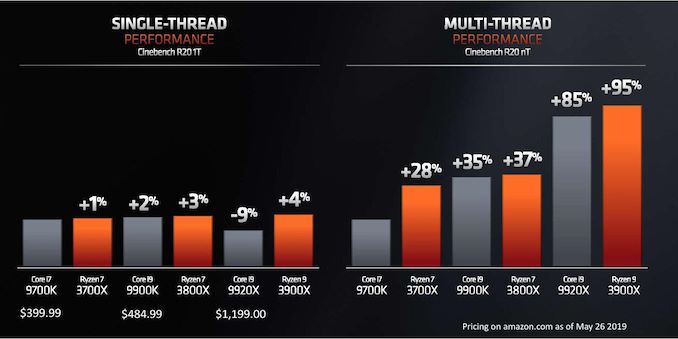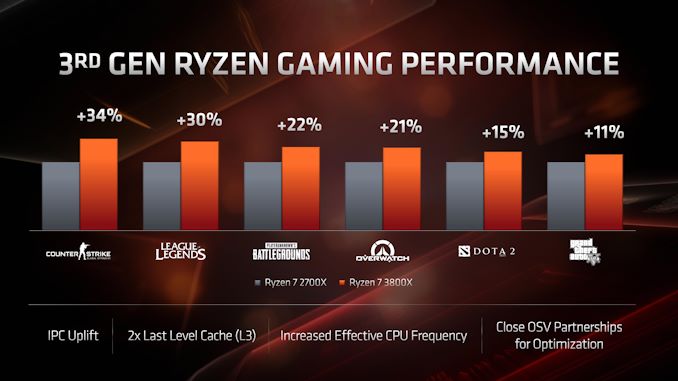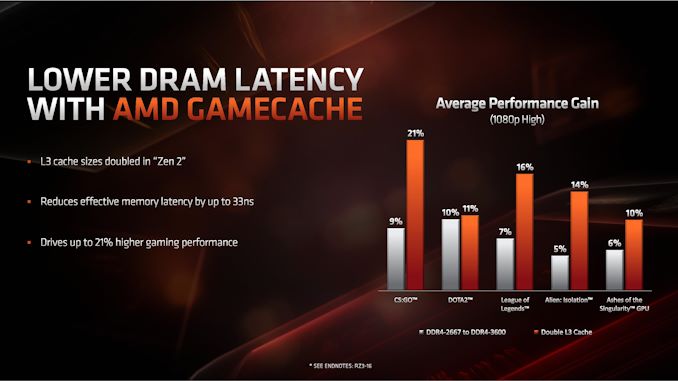AMD Zen 2 Microarchitecture Analysis: Ryzen 3000 and EPYC Rome
by Dr. Ian Cutress on June 10, 2019 7:22 PM EST- Posted in
- CPUs
- AMD
- Ryzen
- EPYC
- Infinity Fabric
- PCIe 4.0
- Zen 2
- Rome
- Ryzen 3000
- Ryzen 3rd Gen
Performance Claims of Zen 2
At Computex, AMD announced that it had designed Zen 2 to offer a direct +15% raw performance gain over its Zen+ platform when comparing two processors at the same frequency. At the same time, AMD also claims that at the same power, Zen 2 will offer greater than a >1.25x performance gain at the same power, or up to half power at the same performance. Combining this together, for select benchmarks, AMD is claiming a +75% performance per watt gain over its previous generation product, and a +45% performance per watt gain over its competition.
These are numbers we can’t verify at this point, as we do not have the products in hand, and when we do the embargo for benchmarking results will lift on July 7th. AMD did spend a good amount of time going through the new changes in the microarchitecture for Zen 2, as well as platform level changes, in order to show how the product has improved over the previous generation.
It should also be noted that at multiple times during AMD’s recent Tech Day, the company stated that they are not interested in going back-and-forth with its primary competition on incremental updates to try and beat one another, which might result in holding technology back. AMD is committed, according to its executives, to pushing the envelope of performance as much as it can every generation, regardless of the competition. Both CEO Dr. Lisa Su, and CTO Mark Papermaster, have said that they expected the timeline of the launch of their Zen 2 portfolio to intersect with a very competitive Intel 10nm product line. Despite this not being the case, the AMD executives stated they are still pushing ahead with their roadmap as planned.
| AMD 'Matisse' Ryzen 3000 Series CPUs | |||||||||||
| AnandTech | Cores Threads |
Base Freq |
Boost Freq |
L2 Cache |
L3 Cache |
PCIe 4.0 |
DDR4 | TDP | Price (SEP) |
||
| Ryzen 9 | 3950X | 16C | 32T | 3.5 | 4.7 | 8 MB | 64 MB | 16+4+4 | 3200 | 105W | $749 |
| Ryzen 9 | 3900X | 12C | 24T | 3.8 | 4.6 | 6 MB | 64 MB | 16+4+4 | 3200 | 105W | $499 |
| Ryzen 7 | 3800X | 8C | 16T | 3.9 | 4.5 | 4 MB | 32 MB | 16+4+4 | 3200 | 105W | $399 |
| Ryzen 7 | 3700X | 8C | 16T | 3.6 | 4.4 | 4 MB | 32 MB | 16+4+4 | 3200 | 65W | $329 |
| Ryzen 5 | 3600X | 6C | 12T | 3.8 | 4.4 | 3 MB | 32 MB | 16+4+4 | 3200 | 95W | $249 |
| Ryzen 5 | 3600 | 6C | 12T | 3.6 | 4.2 | 3 MB | 32 MB | 16+4+4 | 3200 | 65W | $199 |
AMD’s benchmark of choice, when showcasing the performance of its upcoming Matisse processors is Cinebench. Cinebench a floating point benchmark which the company has historically done very well on, and tends to probe the CPU FP performance as well as cache performance, although it ends up often not involving much of the memory subsystem.
Back at CES 2019 in January, AMD showed an un-named 8-core Zen 2 processor against Intel’s high-end 8-core processor, the i9-9900K, on Cinebench R15, where the systems scored about the same result, but with the AMD full system consuming around 1/3 or more less power. For Computex in May, AMD disclosed a lot of the eight and twelve-core details, along with how these chips compare in single and multi-threaded Cinebench R20 results.
AMD is stating that its new processors, when comparing across core counts, offer better single thread performance, better multi-thread performance, at a lower power and a much lower price point when it comes to CPU benchmarks.
When it comes to gaming, AMD is rather bullish on this front. At 1080p, comparing the Ryzen 7 2700X to the Ryzen 7 3800X, AMD is expecting anywhere from a +11% to a +34% increase in frame rates generation to generation.
When it comes to comparing gaming between AMD and Intel processors, AMD stuck to 1080p testing of popular titles, again comparing similar processors for core counts and pricing. In pretty much every comparison, it was a back and forth between the AMD product and the Intel product – AMD would win some, loses some, or draws in others. Here’s the $250 comparison as an example:
Performance in gaming in this case was designed to showcase the frequency and IPC improvements, rather than any benefits from PCIe 4.0. On the frequency side, AMD stated that despite the 7nm die shrink and higher resistivity of the pathways, they were able to extract a higher frequency out of the 7nm TSMC process compared to 14nm and 12nm from Global Foundries.
AMD also made commentary about the new L3 cache design, as it moves from 2 MB/core to 4 MB/core. Doubling the L3 cache, according to AMD, affords an additional +11% to +21% increase in performance at 1080p for gaming with a discrete GPU.
There are some new instructions on Zen 2 that would be able to assist in verifying these numbers.















216 Comments
View All Comments
Kjella - Thursday, June 13, 2019 - link
The Ryzen 1800x got dropped $150 in MSRP nine months after launch, I think AMD thought octo-core might be a niche market they needed strong margins on but realized they'd make more money making it a mainstream part. I bought one at launch price and knew it probably wouldn't be great value but it was like good enough, let's support AMD by splurging on the top model. Very happy it's now paying off, even though I'm not in the market for a replacement yet.deltaFx2 - Tuesday, June 11, 2019 - link
@jjj: Rriigght... Moore's law applies to transistors. You are getting more transistors per sq. mm, and that translates to more cores. ST performance is an arbitrary metric you came up with. It's like expecting car power output (HP/W) go increase linearly every new model and it does not work that way. Physics. So, they innovate on other things like fuel economy, better drive quality, handling, safety features... it's life. We aren't in the 1980s anymore where you got 2x ST perf from a process shrink. Frequency scaling is long dead.The other thing you miss is that the economies of scale you talk about are dying. 7nm is *more* expensive per transistor than 28nm. Finfet, quad patterning, etc etc. So "TSMC gives them more perf per dollar" compared to what? 28nm? No way. 14nm? Nope.
RedGreenBlue - Tuesday, June 11, 2019 - link
Multi-threaded performance does have an effect on single threaded performance in a lot of use cases. If you can afford a 12 core cpu instead of an 8, you would end up with better performance in the following situation: You have one or two multithreaded workloads that will have the most throughput when maxing out 7 strong threads, you want to play a game or run one task that is single-threaded. That single-threaded task is now hindered by the OS and any random updates or processes running in the background.Point being, if you ever do something that maxes out (t - 1) cores, even if there's only one thread running on each, then suddenly your single threaded performance can suffer at the expense of a random OS or background process. So being able to afford more cores will improve single-thread performance in a multitasking environment, and yes multitasking like that is a reality today in the target market AMD is after. So get over it, because that's what a lot of people need. Nobody cares about you, it's the target market AMD and Intel care about.
FunBunny2 - Wednesday, June 12, 2019 - link
"You have one or two multithreaded workloads that will have the most throughput when maxing out 7 strong threads, you want to play a game or run one task that is single-threaded."the problem, as stated for years: 'they ain't all that many embarrassingly parallel user space problems'. IOW, unless you've got an app *expressly* compiled for parallel execution, you get nothing from multi-core/thread. what you do get is the ability to run multiple, independent programs. since we only have one set of hands and one set of eyes, humans don't integrate very well with OS/MFT. that's from the late 360 machines.
yankeeDDL - Thursday, June 13, 2019 - link
I am doing office work, and, according to Task Manager, there are ~3500 threads running on my laptop. Obviously, most threads are dormant, however, as soon as I start downloading something, while listening to music and editing an image, while the email client checks the email and the antivirus scans "everything", I will certainly have more than "10" threads active and running. Having more cores is nearly always beneficial, even for office use. I do swap often between a Core i7 5500 (2 cores, 4 threads) and a desktop with Ryzen 5 1600 (6C, 12T). It is an apples to oranges comparison, granted, but the smoothness of the desktop does not compare. The laptop chokes easily when it is downloading updates, the antivirus is scanning and I'm swapping between multiple applications (and it has 16GB of RAM - it was high end, 4 years back).2C4T is just not enough in a productivity environment, today. 4C8T is the baseline, but anyone looking to future-proof its purchase should aim for 6C12T or more. Intel's 9 gen is quite limited in that respect.
Ratman6161 - Friday, June 14, 2019 - link
Personally I would ignore anything to do with pricing at this point. The MSRP can be anything they want, but the street prices on AMD processors have traditionally been much lower. At ouor local Microcenter for example, 2700X can be had for $250 while the 2700 is only $180. On the new processors, if history is any indicator, prices will fall rapidly after release.mode_13h - Tuesday, June 11, 2019 - link
I think the launch prices won't hold, if that's your main gripe.I would like to be able to buy an 8-core that turbos as well as the 16-core, however. I hope they offer such a model, as their yields improve. I don't need 16 cores, but I do care about single-thread perf.
azazel1024 - Tuesday, June 11, 2019 - link
I have a financial drain right now, but once that gets resolved in (hopefully) a couple of months I think I am finally going to upgrade my desktop with Zen 2. Probably look at one of the 8-core variants. I am running an i5-3570 driven at 4Ghz right now.So the performance improvement should be pretty darned substantial. And I DO a lot of multithread heavy applications like Handbrake, Photoshop, lightroom and a couple of others. The last time I upgraded was from a Core 2 Duo E6750 to my current Ivy Bridge. That was around a 4 year upgrade (I got a Conroe after they were deprecated, but before official EOL and manufacturing ceasing) IIRC. Now we are talking something like 6-7 years from when I got my Ivy Bridge to a Zen 2 if I finally jump on one.
E6750 to i5-3570 represented about a 4x increase in performance multithreaded in 4 years (or ballpark). i5-3570 to 3800x would likely represent about a 3x improvement in multithreaded in 6-7 years.
I wonder if I can swing a 3900x when the time comes. That would be probably somewhat over 4x performance improvement (and knowing how cheap I am, probably get a 3700x).
Peter2k - Tuesday, June 11, 2019 - link
Yeah, but you have to say something negative about everythingbobhumplick - Tuesday, June 11, 2019 - link
i agree. i mean its an incredible cpu line. but just throwing all of that extra die space and power budget at just more cores and cahce. i mean look at the cache to core ratio. when cpu makers just throw more cache or cores at a node shrink it can be because that makes the most sense at the time(the market, workloads, or supporting tech like dram have to catch up to enaable more per core performance) but it can also mean they just didnt know what else to do with the space.maybe its just not possible to go much beyond the widths modern cpus are approaching. even intel is using a lot of space up for avx 512 which is similar to just adding more cores (more fpu crunchers ) so its possible that neither company knows how to balance all those intructions in flight or make use of more execution resources. maybe cores cant get much more performance.
but if so that means a prettyy boring future. especially if programmers cant find ways to use those cores in more common tasks